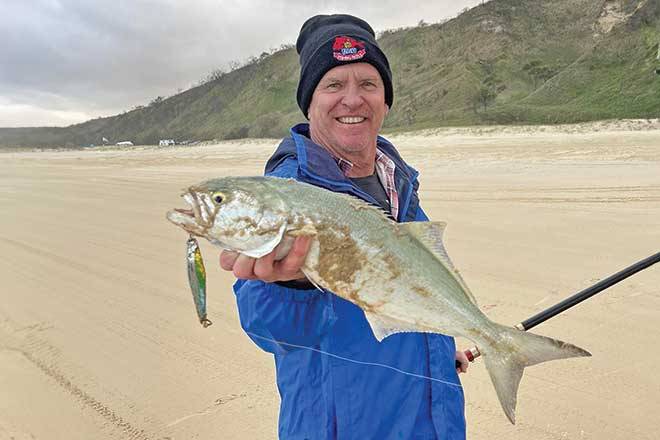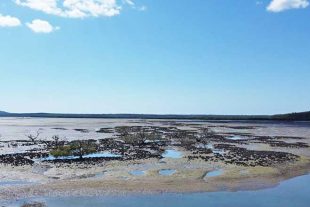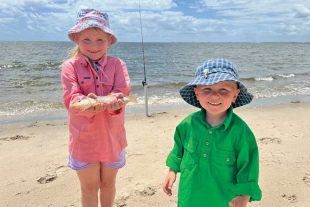A cold westerly wind, chilly mornings and evenings and long rods lined up along the beach signal my favourite time of year.
It’s peak beach-fishing time in Queensland off the open surf beaches from Tweed Heads to K’gari.
For beginners to experienced anglers, tailor are a popular species for a multitude of reasons.
Including that they are can be found in big numbers, fight hard, take lures with gusto and, if treated correctly, can be quite reasonable on the palate.
Time of year
August and September are peak months for tailor along Queensland’s beaches, though bigger models tend to arrive in fewer numbers in October through to December.
I’ve also heard of some large fish in January at North Stradbroke this year.
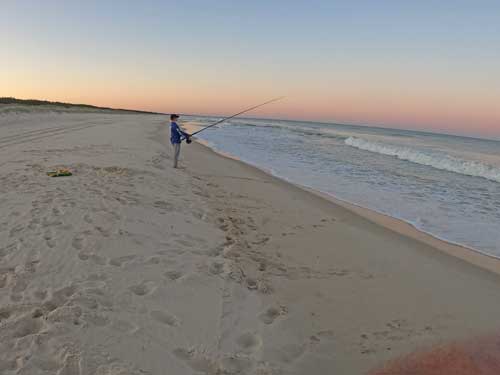
Wind and tailor
A westerly wind is ideal for tailor fishing the beach in Queensland and NSW.
This offshore wind tends to flatten the sea and brings bait into shore.
And, provided there is a little swell for coverage, it will bring tailor into the close gutters chasing the bait.
At the opposite end of the spectrum, a strong southeasterly or northeasterly wind will push up the sea and swell and ‘blow the beach out’.
That is when the surf becomes too big and uncomfortable for both the baitfish and the tailor, with stirred up sand and excessive water movement.
However, the advantage of a pounding sea is that it will remove and shift sand to create deeper gutters and holes close to shore, making ideal conditions when the wind and sea abate.

In a big southeasterly, all is not lost.
You can still look for more protected water behind the leeward side of headlands – opposite side to the direction of the wind – which should hold bait and fish.
Be aware though, if you are fishing K’gari this month, there is an annual closure to all forms of fishing from August 1 to September 29.
This closure includes eastern foreshore water and water within 400m out to sea from the eastern shore at low water, between 400m north of Waddy Point and 400m south of Indian Head.
Beach formations
When exploring for good water for tailor, it can pay to either drive along the beach, if you can, or get up in an elevated position with the sun high on the water to spot deeper holes and gutters.
Try finding a gutter that has an obvious pattern of waves rising but not breaking in darker green water.
Look too for gutters with deep water close to shore and a back bank ideally within casting range that causes whitewater to spill into the gutter, which will provide a little protection for the fish.
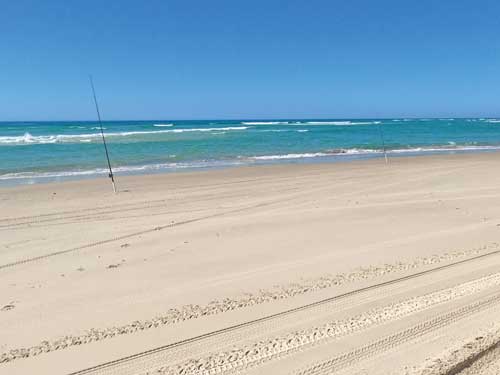
The back bank also traps the bait in close and with it the fish.
A tell-tale sign of deeper water in the dark of pre-dawn or at night is a steep cut away of sand dropping sharply into the water.
Another feature of an ideal gutter is a north and a south entry point, as this allows the fish to enter and exit.
During the middle of the day, you should also look for shadows of fish on shallower rear sandbanks within casting distance from shore.
Beach gutters with coffee rock will also hold fish during the day.
Furthermore, a handy tip for finding tailor on bright sunny days is to choose a gutter with a big sand dune behind it, this will create what I call the ‘shadow effect’ on the gutter.
Time and again our experience in such locations has been that the fish can ‘come on’ earlier than in the sunnier gutters nearby.
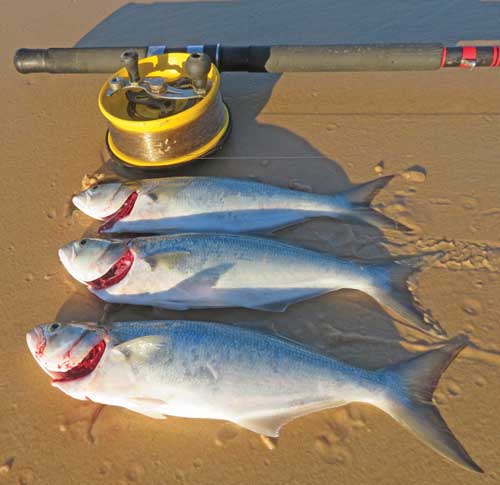
Bait fishing for tailor
Without a doubt, casting and slow retrieving gang pilchard or garfish bait is a very productive method for catching tailor.
This involves simply casting at the bait towards the back bank of the gutter with a suitably sized sinker – depending on the swell, between a size 5-9 ball – and slow retrieving the bait back to yourself, as tailor love a moving bait.
If you find you’re getting fish in closer when retrieving, throw the next casts shorter to the area you caught the last fish.
Though be sure to turn your bail arm or your Alvey quickly into place and take up the slack because the fish can hit as soon as your bait hits the water.
The best bait are fresh individually quick frozen pilchard (rather than block) or, for bigger fish at night, strips of bonito or whole garfish.
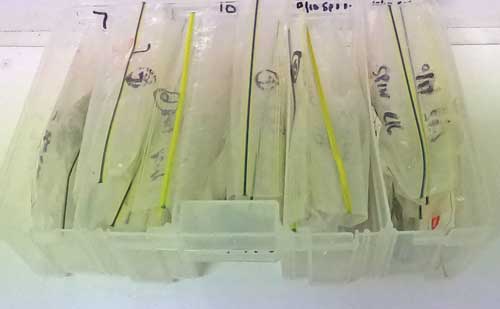
In terms of rig for this cast-and-retrieve method, I love using pre-made Tru-Turn gang hooks with swivels in between.
These make putting the pilchard on much easier than stiffer gangs and the Tru-Turn hooks have an offset shank for better hook-ups.
With an Alvey, I use a short 30lb fluorocarbon trace of about 25-30cm to the first swivel then another 30lb trace of about 60-70cm to the top swivel.
This swivel is to avoid line twist with an Alvey.

I then run a soft bead between the sinker and the bottom swivel to help prevent knot breakage from the pressure of the sinker on the knot, particularly after a few casts.
At times, a strong sideways sweep mid-tide can play havoc with the cast and retrieve technique.
One way to deal with a strong sweep is the use of a star sinker on a paternoster rig to hold you out in the strike zone.
Another tip is, if you see birds ‘working the water’, indicating signs of a tailor school in deeper water beyond casting distance, cut up some pilchard and try to berley the tailor closer to you.

Bait fishing tackle
When it comes to tackle for bait fishing, I use a 13’6” 7-10kg rod with a medium-fast action.
I prefer these over shorter rods because sometimes that extra length means you can reach fish anglers standing beside you can’t, even with 12’ rods.
Alvey side cast reels in 6” or 6.5” are a perfect match for this length rod, and I use thin diameter 20lb monofilament line such as Platypus Super 100.
If you want to use a spinning reel, I’d strongly recommend getting one with saltwater protection.
Finally, when travelling with long rods and big sinkers on the four-wheel-drive, take care not to damage your vehicle in transit.
I use Plonker Pads to wrap the sinker, which can protect the windscreen and roof of your 4WD from the sinker.

Lure fishing for tailor
Lure fishing comes into its own in light to medium-light surf, with the lures being much easier for fish to see.
It means you’ll need to have a straighter more natural retrieve across the gutter between waves, rather than being caught riding up and down regular waves in bigger swell.
In terms of technique, I like to belt out my lure as far as I can.
To maximise my casting distance, I use a long graphite rod and braided line – braid having less resistance through the air due to its thinner diameter.
I also choose quality braid that is not only strong but extra thin for the line strength, such as Shimano Grappler.
Once the lure has landed, I give it a couple of seconds to sink then begin a fast to medium wind with a reel that has a fast retrieval rate of 6:1-plus.
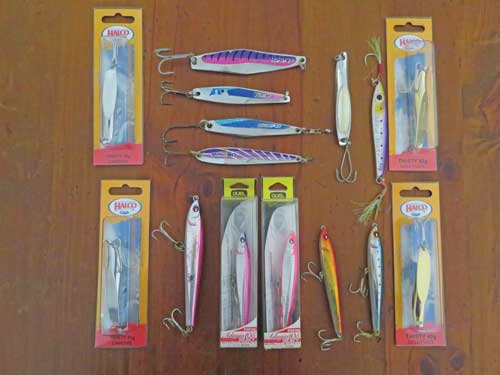
Then as I retrieve, I’ll keep the tip of the rod down to keep the lure from flying out of the water.
I’ll throw in a couple of sideways jerks of the rod and even a short pause or two, to try imitating a fleeing baitfish.
A range of metal lures in 40-65g or bibless hard-body lures in 40-50g are great for fast retrieving for tailor.
When using metals, consider replacing the treble hooks with a single or two, offsetting straight shank hooks back-to-back.
This makes for more secure hook-ups when the fish jump in an attempt to throw the hook.
In very clean water in a smallish swell, I’ll also throw heavy poppers in 40-60g for some awesome topwater action.
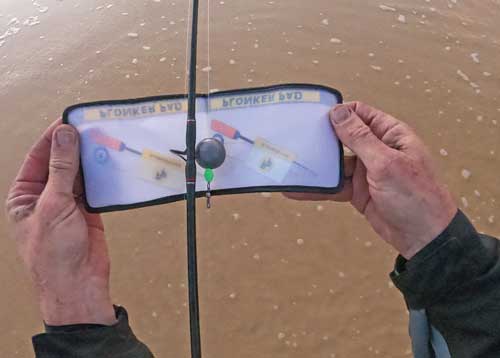
Lure fishing tackle
When it comes to tackle for throwing lures, I use light 5-8kg graphite rods of 11-12’ matched to 4000-5000 size spinning reels with saltwater protection.
I spool these up with 15lb braid or very thin diameter 20lb braid and a long trace of about 2.5m of 20lb fluorocarbon.
So, there you go.
I hope you get among the tailor this season.
In the meantime, don’t forget to check out my social media pages including Facebook at Ontour Fishing Australia.
 Bush ‘n Beach Fishing Magazine Location reports & tips for fishing, boating, camping, kayaking, 4WDing in Queensland and Northern NSW
Bush ‘n Beach Fishing Magazine Location reports & tips for fishing, boating, camping, kayaking, 4WDing in Queensland and Northern NSW

